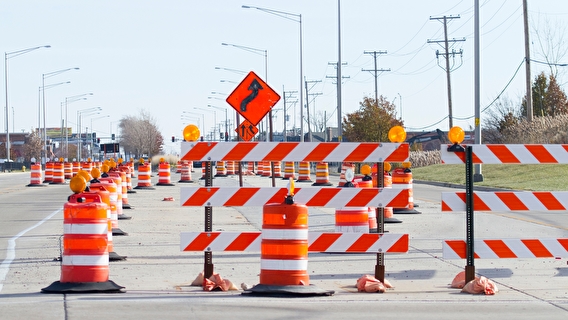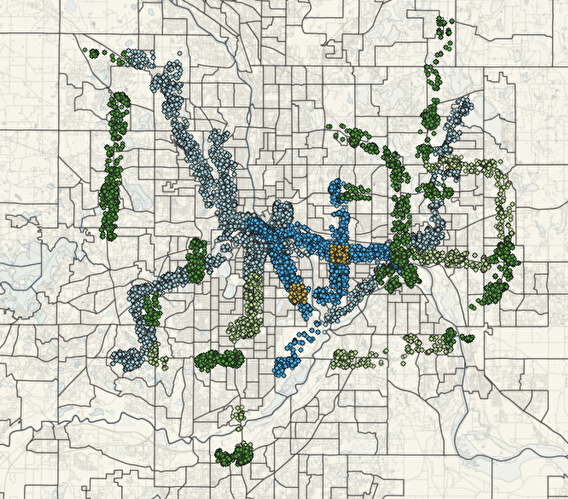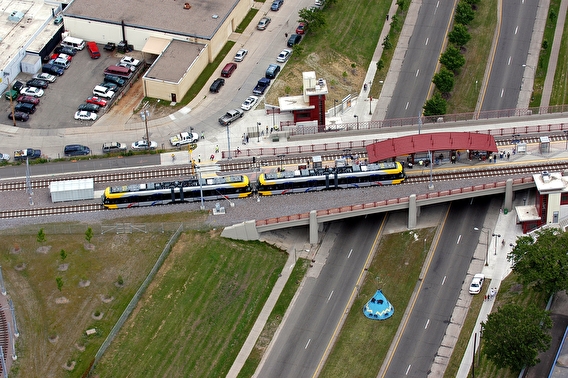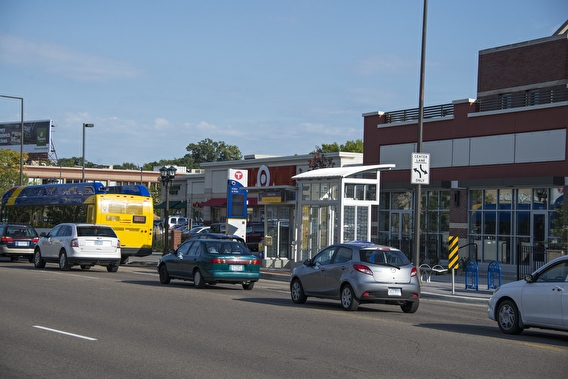
Impacts of Highway and Transitway Construction on Nearby Businesses
Transportation investments—whether transitway or highway—typically benefit regional economies over time, but businesses in nearby corridors and neighborhoods may struggle in the short term. In two comprehensive studies, U researchers examined the impacts of highway and transitway construction projects on nearby businesses in the Twin Cities metro.
Focusing on businesses providing retail, food, or personal services, the team used several econometric approaches to examine how both highway corridor improvements and the construction and operation of new transit affected sales, employment, and concentration of nearby businesses. Their primary dataset, aggregated from an INFOUSA survey, focused on establishments in the seven-county metro in business between 2000 and 2019.

The investigations found that the specific impacts vary widely, depending on many factors—but small business sales take the biggest hit. “We also found that impacts may continue after construction ends,” says Yingling Fan, professor in the Humphrey School of Public Affairs and the studies’ principal investigator. Noah Wexler, a PhD candidate in the Humphrey School, was the co-principal investigator of the studies.
Their findings suggest that businesses of different sizes are differently able to respond to changes in transportation infrastructure around them. “For example, multiple-location firms may be able to weather construction and take advantage of new traffic patterns and economic growth,” Fan says. “But small, mom-and-pop firms may not.”
The researchers recommend that transportation planners and policymakers pay close attention to small businesses and consider policies to soften the brunt of construction. To aid these efforts, they created an interactive online map that lets users see the predicted impacts of highways and transitways on nearby businesses.
The research was funded through the Transit Impacts Research Program (TIRP).
Highways: Impacts vary by project type, urban-suburban divide
The highway analysis examined how state-funded highway improvement projects in the seven-county Twin Cities metro area affected businesses in adjacent census tracts. It included all of MnDOT’s major highway improvements of $15 million or above between 2007 and 2018.
As a whole, the researchers found that the highway projects had no significant impact on sales, employment, and location counts for both single- and multiple-establishment firms. But when projects were divided into two types—those that replaced existing infrastructure versus those that improved operations and flow, such as a new lane—there were differences.

Specifically, when projects simply rehabilitated existing infrastructure, small businesses took a disproportionate loss in sales and jobs. On the other hand, when projects improved traffic flow, small businesses were unaffected—and multiple-location firms such as big-box chains reduced store closures and even opened new locations.
The team also found an urban-suburban difference. In urban areas, single-location businesses were hit especially hard by infrastructure improvements, and store closure rates were higher during and after construction. Food services establishments were especially vulnerable; sales and employment declined after construction ended. Meanwhile, in suburban areas, some modest gains in sales and jobs went to multiple-site firms.
“This study fills an important practical research gap,” Fan says. “The long-term positive effects of highway investments have been well documented—better roads may attract more traffic and business to an area. But there was little research examining the potential short-term drawbacks on adjacent businesses. Our findings, particularly about small business health, can help policymakers and urban planners balance traffic safety and efficiency goals with local economic development objectives.”
“The research provides helpful data about how MnDOT’s past highway projects of different types have caused both short-term drawbacks and longer-term impacts to businesses, especially small, single-location firms,” says Kimberly Zlimen, transit advantages coordinator with MnDOT’s Metro District. “This study highlights the importance of evaluating whether there are alternate ways to stage the work to provide better access to businesses during construction of our future highway projects, or if there is specific marketing or outreach that can be undertaken to support establishments that are especially vulnerable.”
Transitways: Impacts depend on corridor, station area
In the transitway project, researchers used two Twin Cities METRO light-rail transit (LRT) lines and a bus rapid transit (BRT) line—the Blue Line, Green Line, and A Line—as case studies.

“We found that business impacts depended on where a transit line is placed—the characteristics of the corridor and the specific station areas,” Wexler says.
Their models suggest that the Blue Line had a negligible effect on nearby businesses’ sales and employment, regardless of their size. “One explanation is that the Blue Line did not disrupt physical infrastructure to the extent the other lines did,” Wexler says.
The Blue Line was planned and constructed on right-of-way that was already publicly owned. In Minneapolis, the line disrupted downtown street traffic but did not substantially disrupt pedestrian access. Additionally, it did not travel through a particularly commercial area, traveling instead through the central parts of downtown, where most commercial properties are elevated off street level and accessible through the skyway system. And the line traveled a corridor along an existing multilane highway between Minneapolis and Bloomington.
The Green Line connects the downtowns of Minneapolis and St. Paul; in the latter, it runs along the center of University Avenue—one of the Twin Cities’ principal commercial arteries with many small businesses. And in this corridor, business size did matter.
While the team found no significant impacts on employment by single-location firms or sales by multiple-location firms, Wexler says, there was “strong evidence that, on average, the Green Line reduced sales for single-location firms.” Estimates of sales-volume reductions for these firms ranged between 10 to 20 percent depending on model specification, aggregation level, and distance threshold from the line. Importantly, these effects were primarily felt after construction ended. “In fact, the sales declines only became significant after the Green Line opened,” Wexler says. “Residential construction near some of the stations continued business disruptions.”
The Midway area in St. Paul saw the strongest sales decline—between 15 and 40 percent depending on the station area. In contrast, single-location firms around the University of Minnesota saw some sales volume increases beginning with construction, likely due to new development marketed to student residents in Stadium Village and Prospect Park station areas.

The A Line BRT results were mixed. Running through Minneapolis, St. Paul, and Roseville, the A Line touches many commercial areas. The team found some evidence that the line slightly reduced sales and employment, and these effects varied by station area.
Based on these findings, the researchers offer these recommendations for planners and policymakers:
- Pay attention to small, single-location firms near transit stations.
- Take into account the many differences in station areas.
- Engage in thorough, pinpointed analysis of development around stations, along with how construction may disrupt existing access to commercial areas.
- Include financial assistance when a new transit line disrupts traditional access to single-location storefronts, such as pedestrian routes and street parking.
The Metropolitan Council’s LRT construction-related loans and grants for businesses along the Central Corridor line ended when LRT construction was over. “Those assistance programs shouldn’t stop,” Fan says. “Small businesses need help to stay afloat sometimes, in some places, after rail construction is over.”
Fan also believes that single-location firms merit specific attention in light of state and regional equity goals. “These firms were more likely to be owned by people of color or women and to play an important community role,” she says.
Previous TIRP-funded research has shown the positive impact of transitways on the overall regional economy and on Minnesota’s transportation access and equity goals. Future research could incorporate post-2019 data (including pandemic impacts) and provide a longer-term perspective of transit and the region’s prosperity, Fan says.
“This research affirms what we’ve been hearing from communities near the planned Blue Line Extension—that small local businesses need additional support to weather construction so that they can be around to experience the long-term benefits of major transit investments,” says Dan Soler, Hennepin County director of transit and mobility. “It will be useful as we continue our work with partners to prevent displacement and build community prosperity along the route by advancing robust strategies that support businesses and residents before, during, and after construction.”
More Information
What is Commercial Gentrification?
Transit projects are commonly thought to cause commercial gentrification, especially when transit-oriented development follows. Land values go up, rents and taxes become a burden for small firms (many minority-owned), and chains and boutiques move in.
The researchers used the Green Line as a case study to examine the mechanisms of transit-induced commercial gentrification. They defined commercial gentrification as any transit-induced reduction in the sales, employment levels, or establishment count of small single-location firms.
Other researchers and agencies use different definitions, some focusing solely on business closures. Other models are also used for analysis. “Our study adds to the somewhat sparse empirical literature in this area,” Fan says.
Further Reading
- The Effects of Highway Improvement Projects on Nearby Business Activity (Fan, Wexler, 2023)
- Commercial Gentrification Along Twin Cities Transitway Corridors (Fan, Wexler 2022)
Contact
Eric Lind, Center for Transportation Studies, 612-625-1510, elind@umn.edu
Download the Research Brief
Want to print and share the information on this page? Download the four-page research brief (PDF).
Photos: CTS staff, Shutterstock, Metro Transit